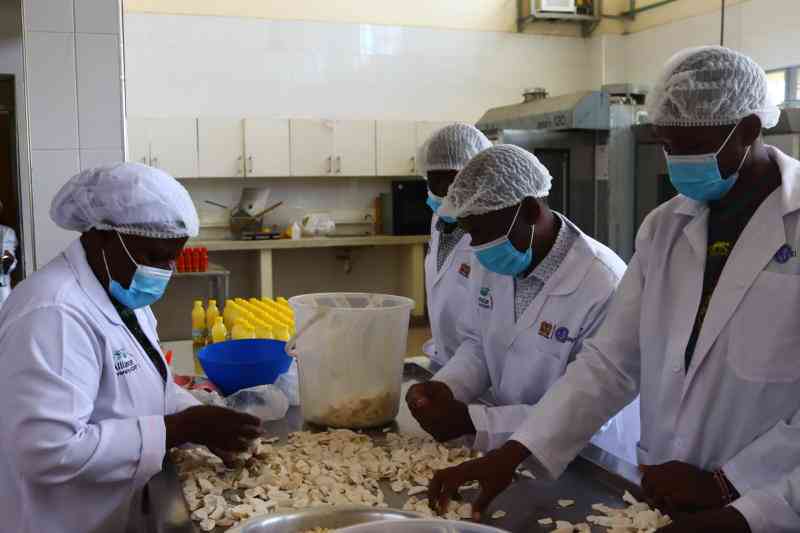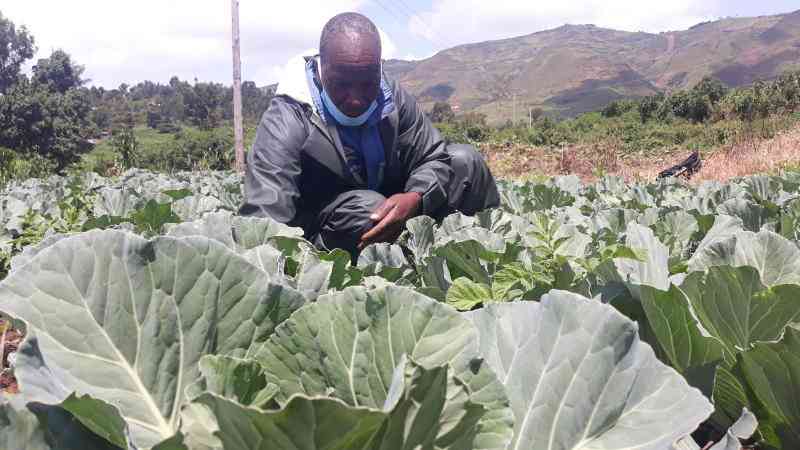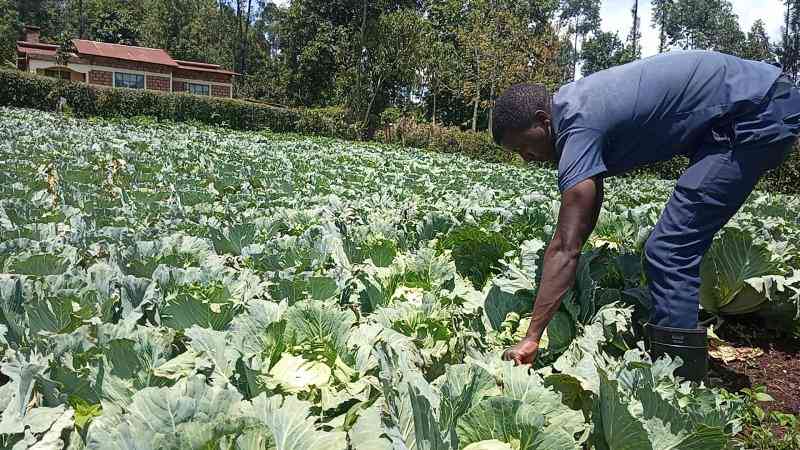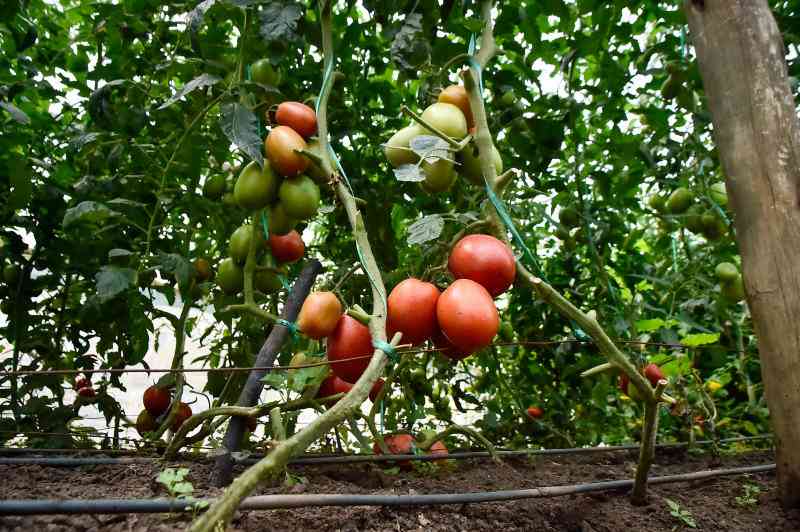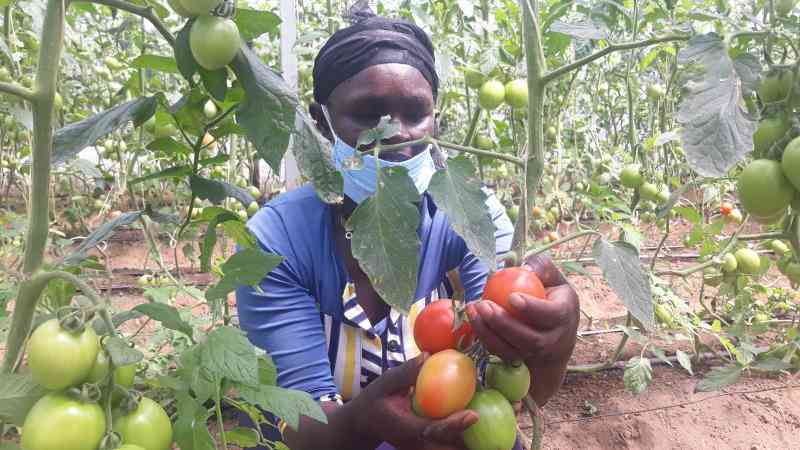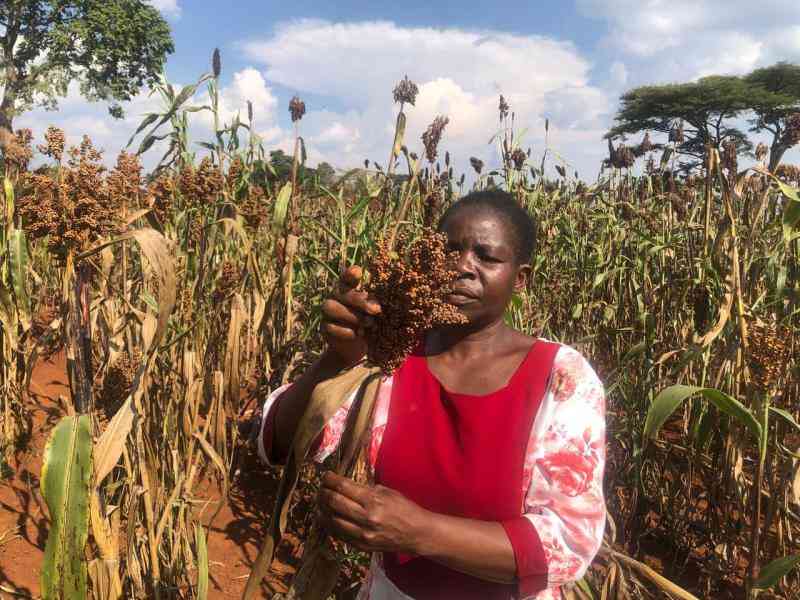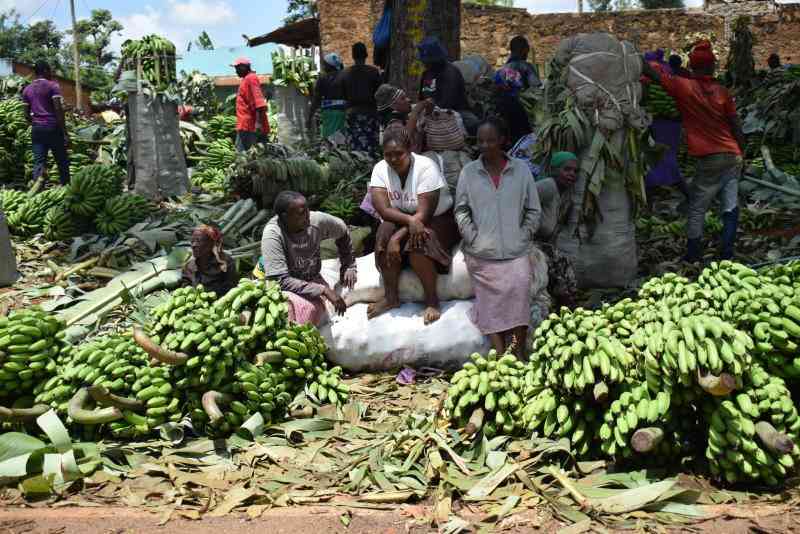
Moses Omungwa attends to his traditional vegetables under drip irrigation in his farm located Emabungo Ward, Luanda Sub County in Vihiga County. [Nanjinia Wamuswa, Standard]
After retiring from boxing, Athanus Nzau ventured into farming, where he keeps both livestock, mostly dairy cows, and various crops. His farm, located in Mutalia area of Matungulu, Machakos County, is dotted with various fruit trees such as paw paws, oranges, mangoes, guavas, avocadoes, bananas, sugar cane, tomato seedlings, and vegetables such as tomatoes, sukuma wiki, and pumpkins.
Smart Harvest visited and found him watering the sundry crops on his farm. The area, Nzau explains, has lately been experiencing little rainfall, and the sole solution is to use irrigation if he has to harvest and increase his production.
“Receding rainfall drove me into drilling a borehole and today I have plenty of water I use to plant crops throughout the year. It is not easy to plant and manage crops without a regular supply of water here,” he explains.
His farm is littered with both old and new pipes used to draw water from the borehole and supply across the farm. A report by the Food and Agriculture Organisation of the United Nations (FAO), “Assessment of Agricultural Plastics and their Sustainability: A Call for Action, 2021,” shows various agriplastics, including fishing gear, greenhouses, tree guards, mulching films, drip pipes, chicken feeders and waterers, and pesticides containers, provide a range of benefits that help farmers, foresters, and fishers to maintain livelihoods, enhance production, reduce losses, conserve water, and reduce chemical inputs.

Athanus Nzau waters crops in his farm, located Mutalia area of Matungulu Sub County and Machakos County. [Nanjinia Wamuswa, Standard]
Moses Omungwa, a farmer from Emabungo Ward, Luanda, in Vihiga County, lauds how irrigation is helping him reap maximum profits from traditional vegetables and bananas. He started farming in 1991 but along the way, started experiencing water shortages due to the effects of climate change. “My produce started going down due to water shortage. At times, I was forced to fetch water using jerry cans to water my farm,” he recalls.
Luckily, he bumped into the National Agricultural and Rural Inclusive Growth Project (NARIGP), a government of Kenya project that is implemented through the Ministry of Agriculture, with funding support from the World Bank, which provided him with irrigation equipment, including a 5000-liter water tank, drip kit, and pond liner. Afterward, he dug a water reservoir and pumps to the tank before distributing it on his farm through drip pipes. “The irrigation equipment is keeping me in the farming game,” he boasts.
However, the report warns that despite the immense benefits of agricultural plastics, they also pose a serious risk of pollution and harm to human and ecosystem health when they are damaged, degraded, or discarded in the environment.
Accumulation of agriplastics such as mulching films in soils reduces agricultural yields. “The same properties that make plastics so useful—their durability and resistance to degradation — also make them nearly impossible for nature to completely break down.”
It further warns that most plastic items never fully disappear; they just break down into smaller and smaller pieces. Those microplastics can enter the human body through inhalation and absorption and accumulate in organs. Microplastics have been found in our lungs, livers, spleens, and kidneys.
It’s for this reason that the government, FAO, and other stakeholders have launched the Financing Agrochemical Reduction and Management (FARM) project: Strengthening investment for the adoption of alternatives and sustainable management of agrochemicals and agricultural plastics in Africa and Latin America through pilots in Kenya and Uruguay.
Child Project
Dubbed the Child Project, it is meant to address the rising human and environmental exposure to health risks associated with pesticides and agricultural plastics in the country.
Carla Mucavi, the FAO Representative in Kenya, says lately, Kenya has recorded a significant increase in crop intensification that has seen the country ranked 4th largest exporter of horticultural products in Africa. This has also seen an increase in pesticides use, and some are persistent organic pollutants and highly hazardous pesticides.
“While we appreciate that pesticides and plastics are essential inputs for agricultural production, their continued use has significantly increased serious risks exposure to human and environmental health,” she explains.
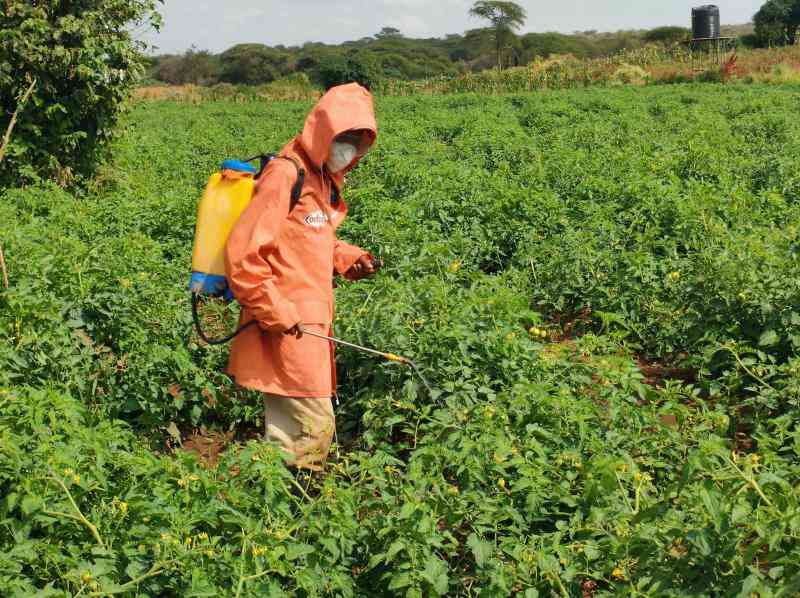
A farmer sprays the farm with pesticides which are becoming dangerous to the environment and human health. [Nanjinia Wamuswa, Standard]
Eng Festus Ng’eno, Principal Secretary, State Department for Environment, explains that agriculture, the mainstay of Kenya’s economy, continues to record significant growth in the agriculture sector, which is a major user of pesticides and agricultural plastics that continue to pose serious risks to human and environmental health.
“In Kenya, pesticide use has soared exponentially in the last 30 years, with over 200,000 tonnes being applied annually. Additionally, the use of agricultural plastics is increasing, with 10 per cent of the 1 million tonnes used yearly in plant and animal production being directly used for agriculture while 50 percent is used for food packaging. Much of these plastics end up in the air and aquatic media,” he explains.
The PS highlighted that Kenya recently hosted the 6th Session of the United Nations Environmental Assembly (UNEA) attended by about 190 countries. The delegates to this meeting agreed that agriculture is a major contributor to the triple planet crisis of climate change, biodiversity loss, and pollution. The need for urgent action on listed persistent organic pollutants, waste, and plastic was a key outcome of the meeting.
Ng’eno reveals that Kenya is also fine-tuning its data on pesticides and plastics. In 2022, the National Environment Management Authority (NEMA) estimated that there were about 50,000 tonnes of non-hazardous agricultural plastic waste produced per year.
“This has expectedly increased. Agricultural films (greenhouse covers and mulch) account for about 70-90 percent of agricultural plastic; irrigation pipes, twines, and nets comprise about 25 percent, while pesticide and fertiliser containers comprise about 3 percent of agricultural plastics. Most agricultural films and irrigation products are used for commercial horticulture,” he says.
Worldwide, data in the FAO report show that in 2019, agricultural value chains used 12.5 million tonnes of plastic products in plant and animal production and 37.3 million tonnes in food packaging.
Furthermore, the agricultural plastic industry forecasts the global demand for greenhouse, mulching, and silage films to increase by 50 percent from 6.1 million tonnes in 2018 to 9.5 million tonnes in 2030.
The crop production and livestock sectors are the largest users, accounting for 10 million tonnes per year collectively, followed by fisheries and aquaculture with 2.1 million tonnes, and forestry with 0.2 million tonnes.
Yet, only small fractions of agricultural plastics are collected and recycled, predominantly in developed economies. There is evidence that elsewhere most plastics are burned, buried, or landfilled. Burning plastics are sources of toxic emissions.
On his farm, Nzau burns pipes that break, burst, or just get old. “I realised these pipes and other plastics are a big waste and occupy large space on the farm and also hinder when you are preparing the land. So, once out of use, I chop them into small pieces and burn them, reducing them into small sizes and then bury them deep in the soil,” he says.
He also sprays his crops to protect them from pests and diseases infestation. He says, “I don’t think you can harvest anything if you don’t apply pesticides at different levels of their growth.” He points out, for tomatoes, if he doesn’t use pesticides, tuta absoluta will damage the entire crop.
Fred Onyango, a poultry farmer, is shocked that the feeders and water troughs he uses are dangerous to human health and the environment. He’s all along believed manufacturers produce equipment that is safe to use anywhere.
However, for over eight years, he has used the plastics, he cannot explain where they go. “You know, feeders and water troughs become useless once they break. I think I have burned some and just thrown others together with other trash,” explains Onyango, adding that farmers need to be educated on the problem caused by these plastics.
Hazardous pesticides
Fredrick Muchiri, the Pest Control Products Board CEO, says they are in charge of regulating pesticides use, and in the Child Project, promises to identify highly hazardous pesticides formulations and also seek alternatives to make agriculture and the environment safe.
Collins Marangu, Director Plant Protection and Food Safety in the Ministry of Agriculture, says although they are tasked to produce enough to feed an increasing population, there’s a need to protect the health aspect of the people and care for the environment.
“The negative impact of Climate Change has brought about increased incidents of insect pests and diseases that have led to increased use of pesticides in agricultural production. These pesticides are poisonous. And for us to have sustainable agriculture, we must take care of ourselves, trade, and the environment,” he explains.
The country has constantly been receiving alerts on the high level of pesticide residues from the Overseas Markets brought about by the misuse of pesticide products.
Hamisi Williams, Deputy Country Representative, FAO, is optimistic that the project will help our production of clean, safe food available for consumption, as it recognizes a gap in the way we use pesticides in the production of foodstuffs as a way of life.
“A plastic pollution-free world is no longer a nice thing to have, it is a must-have for everyone, and therefore, we must strive for a plastics pollution-free world,” he says.
He explains that farmers are very knowledgeable and know what they need but lack alternatives. He’s asked the technical teams to provide alternatives, without which farmers will find it difficult to readjust.
Hamisi recounted how he came face to face with pesticides and their compositions three years ago while controlling desert locusts. He explains, “If we did not take necessary precautions as FAO, the resultant phenomenon would be so devastating.”
The stakeholders are optimistic; the FARM Child project is timely and will catalyze a regulatory and enforcement framework to detoxify the agricultural sector by reducing the use of the most harmful agrochemicals and plastics and promote the adoption of low and nonchemical alternatives for improved human and environmental health.
Carla has challenged the stakeholders to relook at the existing policies and regulatory frameworks to assess the current gaps that may need to be revised to effectively respond to the emerging challenges of increased pesticides and agricultural plastics in the food systems.
The report identifies alternatives and interventions to improve the circularity and sound management of agricultural plastics based on the 6R model (Refuse, Redesign, Reduce, Reuse, Recycle, and Recover).
 The Standard Group Plc is a multi-media organization with investments in media platforms spanning newspaper print
operations, television, radio broadcasting, digital and online services. The Standard Group is recognized as a
leading multi-media house in Kenya with a key influence in matters of national and international interest.
The Standard Group Plc is a multi-media organization with investments in media platforms spanning newspaper print
operations, television, radio broadcasting, digital and online services. The Standard Group is recognized as a
leading multi-media house in Kenya with a key influence in matters of national and international interest.


